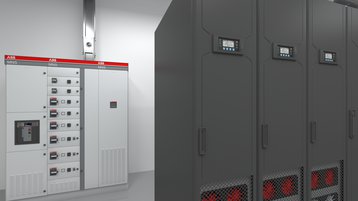ABB has added a feature to its UPS systems to help them contribute energy to the grid when it needs stabilizing.
PowerExchanger lets battery reserves flow into the grid from a data center's uninterruptible power supply (UPS), when electrical power is needed. The feature simplifies the process of connecting the UPS to utility providers' schemes designed to stabilize the electric grid, when power fluctuates because of intermittent renewable supply or changing demands. It can be fitted to new or existing UPS systems.
Facilities store energy in batteries to eliminate brownouts, over-voltages, and electrical noise. They also cover the facility in the event of a grid outage until diesel generators can be started. In recent years, schemes have been proposed to "borrow" some of that battery energy, to shore up the grid when needed, shaving peaks of demand, and filling troughs in supply.
Fast frequency response (FFR) schemes take energy from batteries for very short periods, sometimes milliseconds, to stabilize the grid. These are emerging as commercial markets.
ABB tested the PowerExchange facility at Telia in Helsinki, Finland, which is participating in a "virtual battery" project, Fortum Spring, run by the local utility Fortum (using UPS systems from ABB).
FFR and similar schemes have been unpopular with data center operators, but operators and UPS vendors have been working to make them into a commercial proposition, and there are signs that the idea is becoming more popular, if the proposal can actually produce a revenue stream that reduces the cost of the UPS to the operator.
ABB's Power Exchange is designed for low and medium-voltage data centers, and sets thresholds so that a minimum energy reserve is retained, and the UPS batteries can cover in the event of a complete grid outage. As well as offering power to the grid, the system can cut energy bills by reducing consumption of peak-time energy.
The feature has a programmable maximum and minimum battery capacity and programmable power requirements for several pre-defined modes of operation, including backfeed to the grid. the system will communicate with external controllers via dry contacts or Modbus. It works with battery management systems (BMS)
The system can be used with DPA 500 IEC, MegaFlex DPA IEC, and HiPerGuard MV UPSs, connected in double-conversion or single-conversion topology.
ABB recommends connecting to energy markets via a third party aggregator: "The benefit of selling ancillary services through an aggregator is that participation in the energy market is simplified because they handle grid integration, control signaling and practical implementation, and make it obvious what services should be offered," says the PowerExchange brochure "Aggregators can also consolidate available energy from multiple sites when bidding, so smaller sites can tap into the ancillary services markets."
In the product literature, ABB warns that PowerExchanger will cause extra cycling of the batteries, which can stress them, so it recommends an additional maintenance pack, including two annual maintenance visits, with battery health check and functionality testing. This includes battery impedance and infrared scan for lead batteries and data logging collection and analysis for the more heavily instrumented lithium-ion batteries.
“Against the global backdrop of rising energy prices and supply uncertainty, our customers are under increasing pressure to optimize the use of installed assets and improve efficiencies – all while supporting the transition to renewable energy,” said Paolo Catapane, UPS product manager for ABB. “A powerful way to do this is to harness the untapped potential of the energy storage held within a UPS. PowerExchanger provides demand response functionality, helping to stabilize the grid while generating a healthy revenue for operators and lowering operating costs, making it ideal for use in mission-critical facilities such as data centers.”




